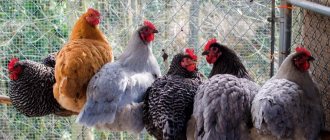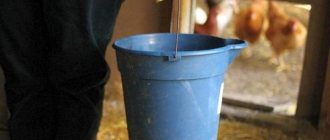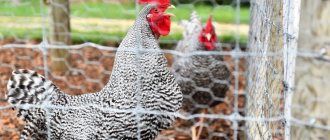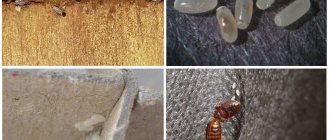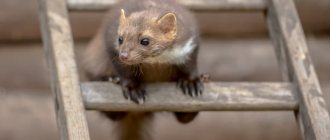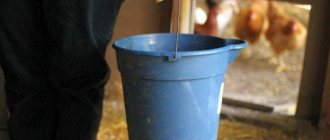2 517
4 comments
3
Author:
Rasskazov Pavel.
Reading time: 2 minutes
Foxes are very smart animals that are able to find the slightest gap to get into the house. Farms located near forests most often suffer from attacks by these predators. For foxes, poultry houses are a source of easy food, so these premises require special protection.
Protecting chickens from foxes
To save birds and protect chickens from attacks by foxes and other predators, farmers take the following measures:
How to scare a fox away from a chicken coop
Stores sell special devices for repelling foxes, stray dogs and even wolves - ultrasonic repellers. They emit ultrasonic waves that cause animals to feel fear and want to leave the nearby area. Such repellers also work well on mustelids.
How to keep foxes away from chicken coops:
Dogs as protection from predators
The best way to escape from predators is to get a guard dog. An ordinary yard dog is not suitable for such work - predators will simply bite a dog that is too small and cowardly. Animal breeds such as Jagd terriers, fox terriers, Caucasian shepherd dogs, and greyhounds are best suited.
Not every dog can resist the temptation to hunt chickens, especially if it is a hunting breed. But if you keep the dog separate from the chickens and let it out into the yard only at night, then it will drive away predators with a menacing bark. This will be good protection against foxes, ferrets, martens and weasels.
Fence or wire
It is worth noting that to protect against foxes there is absolutely no need to build a tall fence; it is enough to add spikes to the existing one.
In the poultry yard, you can bury the wire in the ground to a shallow depth (50 cm), and put old bricks on top of it and also cover them with a layer of soil. Foxes love to dig, this can scare them away. It is better to choose good quality, thick gauge barbed wire as foxes can bite through thin wire.
Also keep an eye out for any paths or areas where a fox could enter your property and try to block them using chicken wire, debris or whatever you have on hand.
If you have a dog, you may want to consider placing a chicken coop near it, as the dog's presence may deter the fox.
How to catch a predator
Bites from wild animals are very dangerous as they can infect you with rabies.
Catching a Fox
Snares or traps are used to catch foxes. Traps come in the following types:
You can use a live trap: a box with a slamming hatch.
Snares and traps are also used to catch ferrets, martens or weasels. A more humane method is live traps.
Catching a ferret
Some farmers catch the ferret with their hands. To do this, you need to watch for the animal in the chicken coop and throw a thick coat over it. Hands need to be protected with strong gloves, because the ferret has very sharp teeth.
Catching weasels and martens
These small predators are caught using the same devices as ferrets. Traps and snares with bait are installed for them, as well as live traps of various designs.
Routes of penetration
How do martens, ferrets and weasels get into chicken barns? The easiest way for them to penetrate is through various cracks and holes. For example, a marten or weasel can crawl through a ventilation hole, open windows, or loosely closed doors. Since these small predators are quite graceful and flexible, they can squeeze into any, even the smallest, crack.
Animals often enter poultry houses through rat or mouse holes. Cracks and potholes in a building can also serve as an opening for them. If there are no cracks or holes, then predators dig up the foundation using sharp claws and fangs. They can also chew a hole in rotten boards.
To prevent furry hunters from entering the chicken coop, a number of actions must be taken:
Uninvited guests - who are they?
The greatest danger to chickens are foxes and predators from the mustelidae family: ferret, marten and weasel. More often they climb into chicken coops in late autumn and winter, when they lack the usual food: mice, rats, lizards and other small animals. Often in winter they settle near human habitation: in garages, sheds, basements, and attics.
These animals are cunning and careful: it is very difficult to catch them at the scene of a crime. Through small cracks and ventilation holes they cleverly enter poultry houses and aviaries. If the animals do not find any cracks, they dig under the walls and mesh fences.
These are predators that are found in all geographical zones from the tundra to steppes and deserts. Animals are found on the outskirts of cities, where they live in basements, parks and landfills.
Foxes approach poultry yards, where they grab stray birds. They dig under enclosures and climb into chicken coops. Animals are especially violent in winter.
How a fox steals chickens
Predators go hunting late in the evening, at night or early in the morning, when there is little chance of encountering a person. Having made his way into the chicken coop, the fox kills one or two birds and drags them away with him. Sometimes she kills several birds at once - the predator likes to cause a commotion in the chicken coop.
Foxes are very smart and careful. Sometimes they manage to bypass the most ingenious traps and deceive the dogs. If the fox is not stopped, it will get into the habit of stealing chickens until it drags them all out.
What attracts foxes to the site
These animals have an excellent sense of smell and are attracted to certain smells:
Foxes must be kept away from the farmstead. It's not just about chickens: these predators are very dangerous for humans, as they carry rabies. A sick animal often attacks people, and its bites are deadly.
Ferrets
These are game animals from the mustelid family that live on forest edges. In the cold season, they move closer to human habitation. They cannot definitely be called pests: ferrets destroy many mice, rats and gophers in the fields. They even attack poisonous snakes. But ferrets are very fond of chicken meat, which makes these animals the worst enemies of poultry farmers.
If a farmer wakes up and finds his birds dead, then this could be the work of a ferret.
Weasels
These animals are small and very agile. Weasels usually settle near human habitation. Homestead owners have an ambiguous attitude towards affection. On the one hand, these animals are excellent hunters of mice and rats, and they catch rodents faster and more efficiently than cats. On the other hand, these are dangerous predators who love to feast on the meat of chickens and chickens.
Weasels rarely attack chicken coops, only if the animals do not have enough regular food. Having made his way to the chickens, the small predator strangles them and kills them in large numbers. During the night, the animal can destroy several dozen birds, of which it will eat one or two chickens.
The weasel is an extremely cunning and aggressive animal. Cats, small dogs, rabbits and other domestic animals can become victims of hungry weasel. It is difficult to catch it, since the animal is very fast and agile. If a weasel is driven into a corner, it can attack a person.
Martens
These are animals with beautiful, valuable fur, the size of a domestic cat. By nature, the marten is a dangerous predator. It lives in forests, but in winter it gets closer to human habitation. The marten settles near humans in lean years, when there are few birds, rodents, fruits and berries in the forests.
At the yard she is interested in poultry. She deftly sneaks into poultry houses, and can squeeze into very narrow cracks. If the owners have not closed the ventilation hole, she will crawl through there.
Once in the chicken coop, the marten kills one of the birds and eats it. She doesn't carry out a bloodbath, but she can get into the chicken coop and drag around a lot of chickens.
It is easier to prevent attacks by predators on chicken coops than to then count losses and catch and kill animals. It is enough to strengthen the enclosures and poultry houses, get a good guard dog, and predators will not touch your birds.
Hereditary poultry farmer, owner of a poultry farm, graduated from St. Petersburg State Agrarian University with honors, author of articles in specialized publications
Source
Behavior of weasels and martens
To get rid of weasels in the chicken coop, you need to know a few facts about this animal and understand the reason for its penetration into poultry.
Weasels rarely raid the chicken coop. She mainly eats rats and mice. Only in the absence of this food does it begin to hunt poultry. There are cases in villages when she sneaks into people's houses and attacks cats and dogs. The weasel has very sharp, needle-like teeth, so it can easily kill a small goose or chicken.
Weasel is difficult to see and catch. With the help of traps, this mission can be completed quite effectively.
The marten is a beautiful nocturnal predator, possessing natural grace and well-developed dexterity. Mystical and supernatural properties have long been attributed to this animal, thanks to its ability to make lightning-fast attacks on its prey and then quickly run away. The habitat is deciduous and coniferous forests, where the marten eats small birds, squirrels and rats. Leads a predominantly nomadic lifestyle. During the period of birth and feeding of her cubs, she settles in tree hollows or among the roots of old trees.
Usually the marten eats rodents and small birds; in rare cases it can catch a hare or black grouse. If there are villages with chicken coops near the forest, the animal may well become an uninvited guest there and feast on poultry. Making its way into barns or human dwellings, it first crushes and gnaws the throat of its victim, and then eats it. It is quite difficult to catch a marten in a chicken coop on your own due to its speed of movement and dexterity. You will need specially equipped traps and traps.
The danger of foxes for chickens
Foxes have a good memory, therefore, if a predator has visited the chicken coop at least once, you need to expect new raids in the future, since birds that are in one place are desirable prey. It is difficult to predict how a fox will behave inside a chicken coop: it all depends on the greed and preferences of the predator.
However, there are also more greedy foxes. They can strangle the entire population of chickens at once. They do this in order to later move them to a secluded place and bury them, making supplies for the winter. Most often, foxes behave this way in the northern regions.
Ferret and methods of dealing with it
The ferret belongs to the mustelidae family. He is very angry and fast. The forest ferret is squat with short and strong legs. Its body is long, adapted to penetrate narrow holes and burrows. He chooses his habitat once and does not wander from one forest to another. Glades and forest edges are its favorite habitats. He prefers not to go into the thicket of the forest.
His stomach is not able to digest plant food, so he gets all the useful substances by eating herbivores.
In one visit, a ferret can destroy 10-15 chickens
During periods of food shortage in the forest, the animal raids villages and villages that are located close to the forest. There he climbs into the chicken coops and destroys all the birds.
Methods of protection
Foxes are cautious and intelligent, and they also have good eyesight and sense of smell. This allows them to bypass even ingenious traps set up by humans. Thus, the issue needs to be approached comprehensively.
Traps
The best option is considered to be traps that allow you to catch a fox without harming it. Such traps are a long cage made of strong metal rods, with hatches at both ends. There is a pedal in the center, and under it there is a mechanism that leads to the slamming of the hatches when the weight changes.
You need to put a piece of meat on the pedal. This way, as soon as the fox gets inside and takes the bait, the cage will slam shut.
Once captured, the animal can be safely taken to a forest or reserve and released where it will be away from people and poultry.
You can make such a trap yourself or purchase a ready-made one.
Trap
Most types of traps that can be useful for catching foxes lead to injury to the animal. In addition, there is a risk of the person or pets getting caught in a trap. Traps should be used only if predators have already been caught several times, but they still return.
To catch, you can use both frame and plate traps . In this case, the structure must be attached with a strong rope or metal chain to the wall of a nearby building or a strong rod driven into the soil. This is necessary so that the animal does not run away and take the trap with it.
Dog
To protect the poultry house and the entire yard from foxes, you can get a dog. Suitable for this:
Loud barking and the smell of a dog will scare away foxes. Shy and small dogs are not suitable, as the fox can quickly scare them away or even bite them.
other methods
Foxes that go hunting do not like too intense light, so you can hang powerful lights with a motion sensor near the chicken coop. Devices powered by solar batteries are well suited for this.
In addition, special repellents can be used to eliminate foxes. Such preparations need to be sprayed on the fence from the outside and inside. The outside of the chicken coop is also subject to treatment. Effective means include:
To protect against foxes, you can use a metal mesh. It should be dug under the fence so that it extends to the surface at least 1 m and is buried 30 cm into the soil. Foxes will not be able to dig under and enter the territory.
Summary
When creating a chicken coop, you need to take into account in advance that a ferret may try to get in there. The fight against this skilled hunter will have results if the poultry house is protected at the stage of its construction. When the structure stands on pillars, the floor is made of thick iron-clad boards or a durable concrete coating, the walls and ceiling do not have holes or cracks, a predator will not be able to dig under and get inside.
If you have this prankster in your chicken coop, it doesn’t matter how you catch it. It is important to do this as quickly as possible
Having caught it, take it away from your site and let it into the forest.
How to protect your chickens and coop from predators
Repelling predators from the chicken coop
The white hen becomes the hawk's first prey . Finnish proverb.
Many poultry farmers claim that garden scarecrows (not scarecrows) are ideal assistants in the fight against predators. What is the reason? As it turned out, a bird of prey, such as a hawk, soon stops reacting even to huge, menacing stuffed animals. Kites and eagles steal chickens too!
The same trick can be done using old CDs. Terrible sparkling “eyes” are capable of driving away not only a hawk, but also smaller contenders - crows and jackdaws. Summer residents also practice rustling plastic bags wrapped around the edges of stuffed animals. There is an opinion that this method is also effective, especially in the dark.
Modern technologies, of course, have gone much further, offering various modifications of electronic devices for use. The repeller lamp operates using an infrared motion sensor, emitting sounds and an alarming pulsating glow when a fox or ferret appears.
This frightens the uninvited guest and he has no choice but to run away. Due to this feature of the devices, it is recommended to install them in places where people do not walk.
And the mass shooting of large birds and four-legged predators will lead to an increase in the population of crows, rodents, and so on, which has been confirmed more than once throughout the world.
Types of traps
To get rid of small pests and successfully fight them, several types of traps have been created that are used to firmly hold the animal. They give a high guarantee and come in plate and frame versions. When an animal gets into it, with the help of springs and plates the device tightly pinches its neck and paws, completely immobilizing it. There are times when an animal runs away with a trap. To prevent this from happening, it must be tightly attached.
For caressing, frame devices are used, which are relatively smaller than plate devices intended for large predators. The cunning animal is able to gnaw through the canvas that serves as the base of the trap and escape.
To ensure that the ferret in the chicken coop remains only a bad memory, when building a farm it is important to adhere to all safety rules and build the premises strong and without cracks.
Some general information
When entering a chicken coop, the ferret will try to decapitate all the chickens, but only eats one. Headless carcasses deteriorate very quickly and become unsuitable for human consumption; as a result, they have to be disposed of or fed to dogs and cats.
Therefore, the ferret is considered one of the most dangerous farm pests. The weasel does not kill chickens in such quantities, however, once it gets into the chicken coop, it will gradually destroy all its inhabitants.
Saving livestock from these two predators is not so difficult, the main thing is to block all routes of entry into the premises. Their sizes are very small; they can fit even into small cracks. If the body length of the largest ferret is about 50 cm and weighs 700-800 grams, then the weasel looks like a long fluffy and flexible rope. Weighing from 60 to 250 grams, its body length is 15-25 centimeters. An animal with such parameters easily enters the barn through a loosely closed door, cracks in the walls, floor, ceiling, mouse holes, and ventilation holes.
Under natural conditions, the weasel hunts around the clock; the ferret prefers to look for prey at night. The weasel living in the wild is not at all afraid of humans, but in populated areas it hunts only at night, and not only chickens; its prey can be rabbits, geese, ducks, mice and rats.
If you tame a ferret and weasel at an early age, they will not attack their owner’s chickens, but will hunt rats, mice and neighbor’s birds. Their fangs and claws are quite sharp, which allows them to easily cope with small domestic animals.
Protecting your chicken coop from predators
The fox spoke - lock the chicken coop . Russian proverb.
According to experienced poultry farmers, it is better to organize preventive methods in the fight against four-legged predators, starting with the construction of a poultry house. In this sense, the recommendations are incredibly simple. How to protect your chickens and chicken coop from predators? Use “inedible” materials for insulation, for example, mineral wool.
Get rid of cracks in the walls of the chicken coop; if there are damaged boards, replace them and cover them with sheet metal. The use of simple technologies will also be life-saving - plaster the walls of the chicken coop using metal mesh.
Floors where there is a fraction of broken glass in the cement-concrete mixture will be ideal against penetration by digging, and the “living” surface will be covered with a thick board of hardwood.
Similarly, take care of the open range area for your chicken family. The chain-link mesh must be dug no less than the depth of the shovel bayonet. Stone seals should be laid along the perimeter, close to the mesh. This approach will prevent animals from digging to enter the poultry walking area.
Eliminate the potential danger hidden in the pile of empty boxes, barrels, piles of branches and boards located around the chicken coop or aviary. Another remedy that is also quite effective is a line of evergreens instead of deciduous ones.
Unlike randomly scattered objects and garden utensils, which create a chaotic perception in chickens and allow their enemies to take advantage of this, orderly growing coniferous trees and deterrent devices harmonize, becoming a protective ecosystem of the poultry yard.
Precautionary measures
So that you don’t have to think about how to get rid of forest predators and not make traps, we advise you to follow some recommendations. First of all, really, get a good dog, he will protect you from thieves and your chickens from other forest predators. Secondly, strengthen your chicken coop, make sure there are no holes or cracks anywhere.
Flat stones or slabs can be placed around the walking area to prevent predators from digging under the area. Keep your chickens' habitat and surrounding area clean. If there are empty boxes, boxes or barrels nearby, this will serve as additional shelter for predators.


